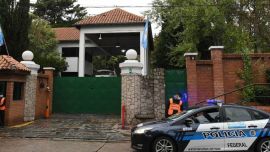Argentina’s plan to buy back US$1 billion of global bonds from creditors is sparking a debate over what, exactly, constitutes a default.
The world’s most-watched credit assessors are split after Moody’s Investors Service classified the nation’s plan to repurchase its debt in the open market as a distressed exchange. It’s a call neither Fitch Ratings nor S&P Global Ratings have chosen to echo despite shared doubts about Economy Minister Sergio Massa’s strategy.
“We are bound by our definitions to look at this exchange in the context of the original promise of the bonds, which is retiring this debt at par value,” said Jaime Reusche, assistant vice-president for sovereign risk at Moody’s in New York. “It’s hard to argue that an issuer rated as low as Argentina could do a buyback that isn’t distressed because their rating implies credit worthiness is already extremely low.”
Such a designation would have real implications for Argentina, which wrapped up its ninth default with a US$65-billion restructuring in 2020. A 10th episode would make it even harder for the President Alberto Fernández’s government to return to international capital markets.
A spokesman for Argentina’s Economy Ministry didn’t immediately respond to a request for comment.
Argentina’s Economic Planning Secretary Gabriel Rubinstein downplayed the default designation, telling local outlet Bloomberg Linea it was more important that Moody’s maintained its rating on the nation at Ca, the agency’s second lowest.
Different criteria
The saving grace for Argentina is a different set of criteria held by S&P and Fitch. The rating companies, while concerned by the cash-strapped country’s maneuver, have held back on a default rating as bond payments keep being made. S&P and Fitch maintained their ratings for Argentina at CCC+ and CCC-, respectively.
Argentina’s Economy Ministry is using dollars held by the Treasury to fund direct repurchases the securities at the market rate, and plans to offset the cost of the purchases from money it expects to save from energy imports it presumes it won’t need in 2023.
While Argentina’s dollar bonds initially climbed after the buyback was announced, the notes have since pared gains.
“While participating bondholders would receive less than originally promised, at current and expected bond prices under our methodology, we don’t consider this transaction to be a distressed exchange,” S&P Global analysts including Lisa Schineller wrote in a January 20 report.
Todd Martinez, a rating analyst at Fitch, also pointed out Argentina’s dwindling international reserves and the risk associated which such a buyback plan. While strong issuers can sometimes repurchase debt in a responsible method, it’s almost impossible for a deeply challenged government.
Under Fitch’s criteria, an exchange is considered distressed if the operation was carried out to avoid a missed debt payment.
“We don’t think that condition has been met,” Martinez said in an interview. Still, “in this case, the buyback is exacerbating Argentina’s already extremely weak liquidity situation.”
For Reusche, the difference lies in how Moody’s rates sovereign issuers based on the estimated losses for bondholders. While Argentina’s buyback is voluntary, he cited the lack of transparency surrounding the operation. Because the purchases are happening directly in the market, there was no published tender offer document.
“Unfortunately, when people think of default they immediately think of nonpayment,” Reusche said. “But this should really be called a credit event, which could encompass a hard default, a restructuring, or distressed exchange.”
related news
by Scott Squires, Bloomberg





















Comments